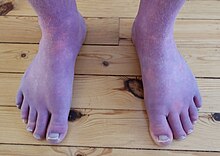User:Mr. Ibrahem/Postural orthostatic tachycardia syndrome
| Postural orthostatic tachycardia syndrome | |
|---|---|
| Other names | Postural tachycardia syndrome (POTS) |
 | |
| Cyanosis of the limbs due to POTS | |
| Specialty | Cardiology, neurology |
| Symptoms | With standing: lightheadedness, trouble thinking, blurry vision, weakness[1] |
| Usual onset | Around age 20[1] |
| Duration | > 6 months[2] |
| Causes | Variable[3] |
| Risk factors | Family history[1] |
| Diagnostic method | An increase in heart rate by 30 beats/min with standing[1] |
| Differential diagnosis | Dehydration, heart problems, adrenal insufficiency, Parkinson disease[4] |
| Treatment | Avoiding factors that bring on symptoms, increasing dietary salt and water, compression stockings, exercise, cognitive behavioral therapy, medications[1] |
| Medication | Beta blockers, pyridostigmine, midodrine, and fludrocortisone.[1] |
| Prognosis | ~90% improve with treatment[5] |
| Frequency | ~ 500,000 (US)[4] |
Postural orthostatic tachycardia syndrome (POTS) is a condition in which a change from lying to standing causes an abnormally large increase in heart rate.[1] This occurs with symptoms that may include lightheadedness, trouble thinking, blurred vision or weakness.[1] Other commonly associated conditions include Ehlers–Danlos syndrome, mast cell activation syndrome, irritable bowel syndrome, insomnia, chronic headaches, chronic fatigue syndrome and fibromyalgia.[1]
The causes of POTS are varied.[3] Often, it begins after a viral infection, surgery or pregnancy.[5] Risk factors include a family history of the condition.[1] Diagnosis in adults is based on an increase in heart rate of more than 30 beats per minute within ten minutes of standing up which is accompanied by symptoms.[1] Low blood pressure with standing, however, does not occur.[1] Other conditions which can cause similar symptoms, such as dehydration, heart problems, adrenal insufficiency and Parkinson disease, must not be present.[4]
Treatment may include avoiding factors that bring on symptoms, increasing dietary salt and water, compression stockings, exercise, cognitive behavioral therapy (CBT) and medications.[1][6] Medications used may include beta blockers, pyridostigmine, midodrine or fludrocortisone.[1] More than 50% of people whose condition was triggered by a viral infection get better within five years.[5] About 90% improve with treatment.[5] It is estimated that 500,000 people are affected in the United States.[4] The average age of onset is 20 years old, and it occurs about 5 times more often in females.[1]
References[edit]
- ^ a b c d e f g h i j k l m n o Benarroch EE (December 2012). "Postural tachycardia syndrome: a heterogeneous and multifactorial disorder". Mayo Clinic Proceedings. 87 (12): 1214–25. doi:10.1016/j.mayocp.2012.08.013. PMC 3547546. PMID 23122672.
- ^ Lawrence, Ruth A.; Lawrence, Robert M. (2010). Breastfeeding E-Book: A Guide for the Medical Professional. Elsevier Health Sciences. p. 580. ISBN 9781437735901. Archived from the original on 2019-03-07. Retrieved 2020-06-08.
- ^ a b Ferri, Fred F. (2016). Ferri's Clinical Advisor 2017 E-Book: 5 Books in 1. Elsevier Health Sciences. p. 1019.e2. ISBN 9780323448383. Archived from the original on 2020-07-06. Retrieved 2020-06-08.
- ^ a b c d Bogle, JM; Goodman, BP; Barrs, DM (May 2017). "Postural orthostatic tachycardia syndrome for the otolaryngologist". The Laryngoscope. 127 (5): 1195–1198. doi:10.1002/lary.26269. PMID 27578452.
- ^ a b c d Grubb BP (May 2008). "Postural tachycardia syndrome". Circulation. 117 (21): 2814–7. doi:10.1161/CIRCULATIONAHA.107.761643. PMID 18506020.
- ^ Kizilbash, SJ; Ahrens, SP; Bruce, BK; Chelimsky, G; Driscoll, SW; Harbeck-Weber, C; Lloyd, RM; Mack, KJ; Nelson, DE; Ninis, N; Pianosi, PT; Stewart, JM; Weiss, KE; Fischer, PR (2014). "Adolescent fatigue, POTS, and recovery: a guide for clinicians". Current Problems in Pediatric and Adolescent Health Care. 44 (5): 108–33. doi:10.1016/j.cppeds.2013.12.014. PMC 5819886. PMID 24819031.
